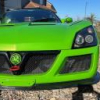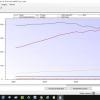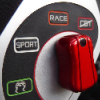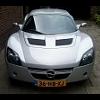Our standard valve springs bounce at around 7000-7200 rpm I've been running 7500 rpm since last year but my engine is not standardpeople seem to spin bearings more often than bend rods something as a driver you do have control over is revs , a long stroke 95mm gets a bit grumpy in an exponential manner at high rpm.

Max Safe Power From Standard 2.2
#21

Posted 16 November 2014 - 09:55 AM
#22

Posted 16 November 2014 - 09:58 AM
Our standard valve springs bounce at around 7000-7200 rpm I've been running 7500 rpm since last year but my engine is not standardpeople seem to spin bearings more often than bend rods something as a driver you do have control over is revs , a long stroke 95mm gets a bit grumpy in an exponential manner at high rpm.
try changing into second gear , you will go much faster and use less petrol , then progress to 3rd , 4th and 5th ![]()
#23

Posted 16 November 2014 - 10:05 AM
I will have to have some driving lessons do I can learn to go into second gear I really need a third leg as there is three pedalstry changing into second gear , you will go much faster and use less petrol , then progress to 3rd , 4th and 5th
Our standard valve springs bounce at around 7000-7200 rpm I've been running 7500 rpm since last year but my engine is not standardpeople seem to spin bearings more often than bend rods something as a driver you do have control over is revs , a long stroke 95mm gets a bit grumpy in an exponential manner at high rpm.
#24

Posted 16 November 2014 - 10:06 AM
move the seat closer and your third leg will reach
#25

Posted 16 November 2014 - 10:07 AM
That would meAn having the car corner weighted again as I will need a passenger to tickle my ballsmove the seat closer and your third leg will reach
Edited by CHILL Gone DUTCH, 16 November 2014 - 10:08 AM.
#26

Posted 16 November 2014 - 10:13 AM
That would meAn having the car corner weighted again as I will need a passenger to tickle my balls
No, just get that done at home, and put on this:

You may need a bit more time to get into the car though.
#27

Posted 16 November 2014 - 10:18 AM
I can't think of anyone else that's thrown a rod and if there is I doubt you'd need more than 1 hand to count them all. And yes Joe, Thank you for finding the limit for us allpeople seem to spin bearings more often than bend rods
#28

Posted 16 November 2014 - 10:36 AM
What's the circumference on that
That would meAn having the car corner weighted again as I will need a passenger to tickle my balls
No, just get that done at home, and put on this:
You may need a bit more time to get into the car though.
#29

Posted 16 November 2014 - 10:40 AM
#30

Posted 16 November 2014 - 11:12 AM
What's the circumference on that
They come in various. Just measure up.
http://www.male-esse...ntactus.sc#faq3
#31

Posted 17 November 2014 - 07:10 AM
J've heard that there are some différences between engines made in Germany and some engines made in the USA.
The rods are weaker on some US made engines.
Anyone to confirm.
There were some pictures on the german forum showing the rods différences.
Anyone has access to them ?
Edited by 2-20, 17 November 2014 - 07:11 AM.
#32

Posted 17 November 2014 - 09:32 AM
Mines been SC'd at 255 bhp for 5 years, 32000 miles and many track days. Still on original clutch and everything internally as it came from the factory.
Once you start moving up from that it appears lots of bills and misery follows.
Martin S
#33

Posted 17 November 2014 - 09:24 PM
I dropped a valve at 260 bhp.
The valves are supposed to be the weakest point, and retrospectively I suspect it's because the OBD tuner software runs the engine much leaner and therefore hotter. I don't believe that raising the power would have put it more at risk though.
#34

Posted 17 November 2014 - 10:06 PM
It's partly why the z22 run so crazy ich in std form, to cool the exhaust valves to keep them in the headI dropped a valve at 260 bhp. The valves are supposed to be the weakest point, and retrospectively I suspect it's because the OBD tuner software runs the engine much leaner and therefore hotter. I don't believe that raising the power would have put it more at risk though.
#35

Posted 17 November 2014 - 10:49 PM
Didn't your engine have a bit of a hard life before hand?I dropped a valve at 260 bhp. The valves are supposed to be the weakest point, and retrospectively I suspect it's because the OBD tuner software runs the engine much leaner and therefore hotter. I don't believe that raising the power would have put it more at risk though.
#36

Posted 18 November 2014 - 09:16 AM
chocolate exhaust valves
#37

Posted 18 November 2014 - 09:33 AM
Didn't your engine have a bit of a hard life before hand?I dropped a valve at 260 bhp. The valves are supposed to be the weakest point, and retrospectively I suspect it's because the OBD tuner software runs the engine much leaner and therefore hotter. I don't believe that raising the power would have put it more at risk though.
Yes, but I can't see how a valve dropping could stem from filling the engine with water rather than coolant. I'm putting it down to chance engine failure, but I wonder if it will become more systematic as more people run the OBD software on Z22SE engines (in contrast to CS maps which are very rich). Personally I will feel much happier when my SAAB engine with sodium filled valves is fitted.
#38

Posted 18 November 2014 - 10:26 AM
I dont think OBD-Tuner runs lean. It's a computer that does exactly what you want it to do. If it runs lean then a mechanical failure can be the culprit or you did not programmed it right.
Correct me when I'm wrong.
Futhermore about hp-limits on the Z22SE. Limits are variable as dynometers are variable.
Getting 230 bhp on a low-reading dyno and then break a rod will not set the mark on 230 bhp. This 230 bhp could've been 260 bhp on a happy dyno.. who'll tell.
GM tested a Z22SE engine (specs unknown) with a 100hp NOS-shot and broke all four rods at 286 hp (enginedyno meassured). Getting 286 hp on a 100hp NOS-shot means the engine was allready pushing 186 hp right? I guess they've added some extra mods to the stock engine to get there. Anyway, rods didn' t like the NOS-shot, no word about the pistons.
Klasen pushed a DBilas 2.2 turbo set up to 250 whp (wheel HP that is), reading just 270 bhp. Now dynojets are a bit on the brightside but 230ish wheelhp is very do-able and the yanks do it a lot with their ZZP en Hahn turbo setups. The big gamble with you SC guys is to guestimate the drivetrainlosses and see how much hp you jank at the pistons.
#39

Posted 18 November 2014 - 10:46 AM
but getting 250 WHP from a turbo setup is vastly different loading on the pistons/rods than using a belt driven charger giving the same WHP.
Winstar provided the data a while ago stating that the belt driven charger (the usual one) took approx 30bhp to fun at max output.
You then factor in the engines own internal losses such as friction, pumping etc and you get nearer the actual forces seen by the pistons and rods.
I agree that destruction testing using NOS isnt hugely helpful as it does give the rods masses of loading, so any weakness would be amplified by that.... I would hope they used a progressive application of it too, otherwise its no wonder they gave up. Although saying that, the 20XE will take a 100shot on a standard bottom end with a progressive controller.
I would hope its not a stab at OBDT, but if you give the users the ability to calibrate it, and there is some scope for not knowing fully what they are doing, and the std Z22 cal is very rich, you can see why some would pull it leaner (but still rich) and cause heating problems with the valves, then add in the charger to heat up the exhaust even more and you are into a very very grey area.
Again, this is a huge reason why calibration and "stuff" integration is getting more and more complex with modern engines and chooning..... possibly far beyond the capabilities of even "professionals"
#40

Posted 18 November 2014 - 10:50 AM
hate the use of bhp in this thread
250*hp at 2000rpm , completely different to 250*hp at 7000rpm
Torque is much more dangerous to engine internals
0 user(s) are reading this topic
0 members, 0 guests, 0 anonymous users




















